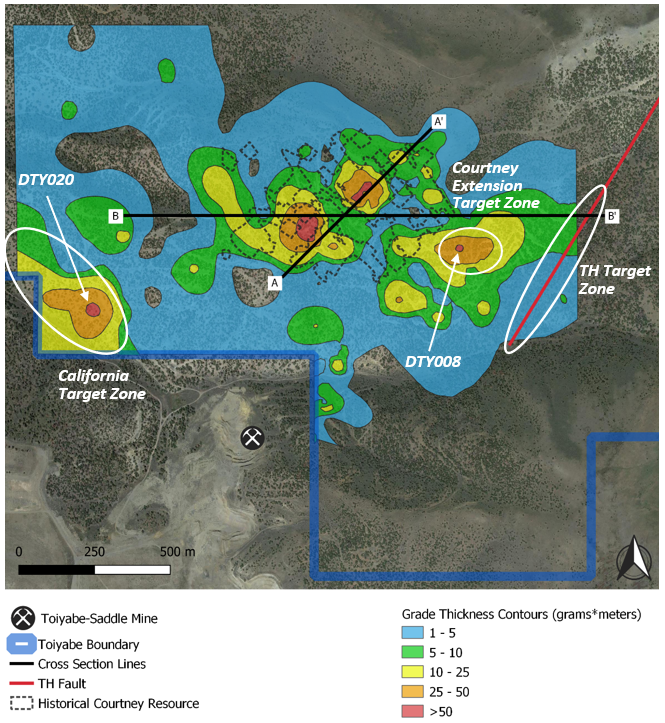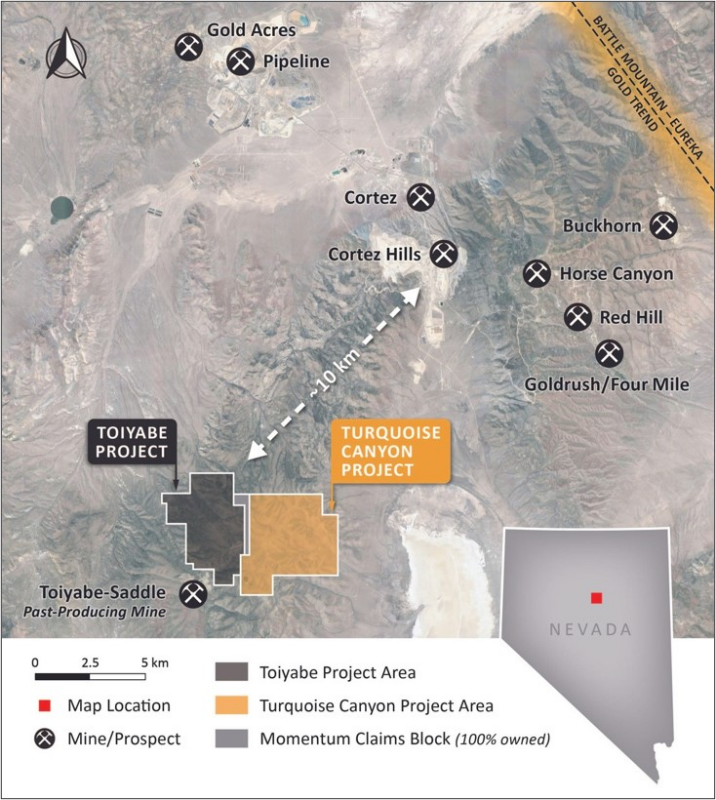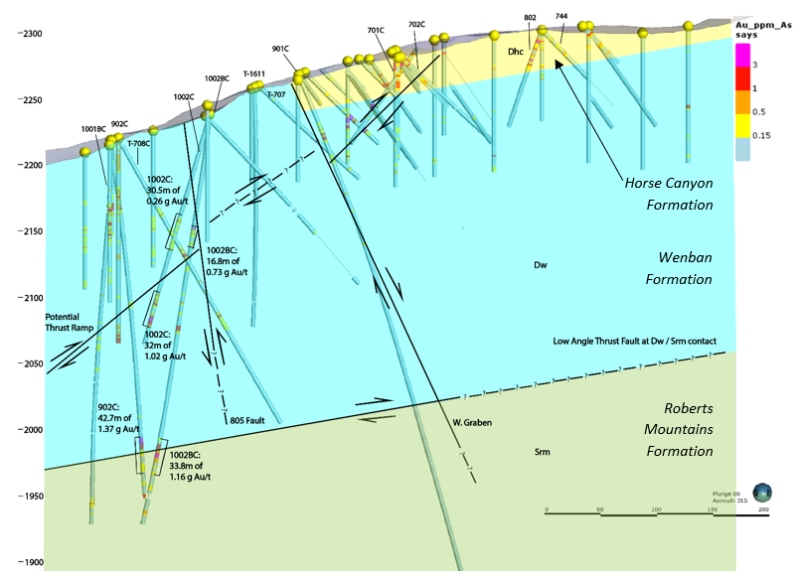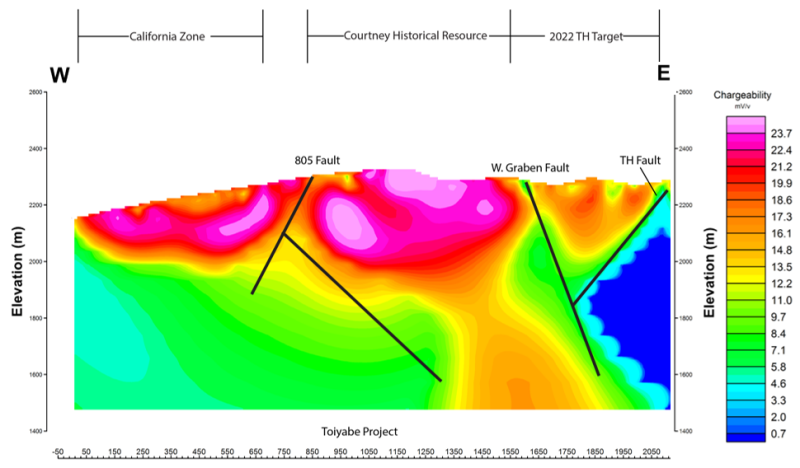Archive
Amended: Westward Gold Provides Update on Drill Targeting and Historical Data Review
 | |||||||||
 |  |  |  |  | |||||
Vancouver, British Columbia – TheNewswire - December 16, 2021 – Westward Gold Inc. (CSE:WG), (CNSX:WG.CN), (FSE:IM50) (“Westward” or the “Company”) is pleased to provide an update on the results of an extensive technical review of historical drill data at its Toiyabe Gold Project in Lander County, Nevada (“Toiyabe”). The historical information analyzed during this review, in combination with field activities carried out by the Company in recent months (see press releases dated August 10, October 5, and November 9, 2021), are providing the foundation for Westward’s targeting efforts and a maiden drill campaign slated for the first half of 2022.
The review of historical drill data was led by Steven Koehler, a member of the Company’s Technical Advisory Committee, and Dave Browning, Vice President of Exploration. Mr. Koehler is an exploration geologist with extensive experience working along the Battle Mountain – Eureka Trend, and has been involved in 11 Carlin-type gold discoveries, including nearby Cortez Hills.
Dave Browning, Vice President of Exploration, noted: “The vast amount of data we’ve accumulated – through both historical review and Westward-led programs in 2021 – continues to suggest that we find ourselves in a highly-prospective gold environment. We have no shortage of near-term targets and we’re excited to test out our theses through the drill bit in 2022.”
Figure 1: Toiyabe Location Map
The review covered over 30 years of exploration data from 6 previous operators, and results demonstrate widespread near-surface gold mineralization. The Company’s maiden drill campaign will focus on under-explored areas, including testing potential lateral extensions of the 173koz historical gold resource(1) at the Courtney Zone, which has seen the bulk of drilling activities to date.
Given the substantial amount of historical drill holes across the property for which data was available (~350), results have been evaluated using grade thickness (expressed in gram-meters). This metric is an effective tool when dealing with a large number of intersections over many holes, as it accounts for both higher-grade, narrower intervals, as well as lower-grade, wider intervals. Westward’s technical team calculated grade thickness and mapped results across Toiyabe to highlight significant mineralization trends, and to help identify potential new zones of open mineralization.
Review Highlights(2):
-
Large areas of open mineralization identified outside of the historical resource at the Courtney Zone
-
Understanding of lithologic/stratigraphic (Figure 3) and structural (Figure 4) controls on mineralization has led to the identification of step-out drill targets
-
Completion of a drill hole grade thickness contour map which contributed to the identification of E-W and NW-SE trends of mineralization at Toiyabe
-
Open mineralization will be tested in step-out drilling
Grade Thickness Highlights(2):
-
346 holes were evaluated; mineralization remains open in all directions and at depth
-
45 holes identified with 0.14 g Au/t beginning at the current topographic surface
-
271 holes of >1 gram-meters (78% of total holes intersected anomalous gold)
-
97 holes of >10 gram-meters (36% of mineralized holes / 28% of all holes)
Notable Near-Surface Intersections(2):
The following intersections represent near-surface mineralization discovered in early drilling efforts from previous operators. Subsequent drilling confirmed the shallow mineralization, while also identifying a second deeper mineralized zone.
-
DH88-280: 16.8m @ 3.5 g Au/t, from a depth of 10.6m (incl. 10.7m @ 5.4 g Au/t)
-
DH88-296: 19.8m @ 4.03 g Au/t, from surface (incl. 13.7m @ 5.54 g Au/t)
-
DH88-369: 27.4m @ 2.6 g Au/t, from a depth of 41.2m (incl. 9.1m @ 7.29 g Au/t)
-
DH88-373: 67.1m @ 0.88 g Au/t, from surface (incl. 21.3m @ 2.1 g Au/t)
-
DTY008: 22.9m @ 1.62 g Au/t, from 103.6m (incl. 15.2m @ 2.20 g Au/t)
-
DTY020: 15.2m @ 0.72 g Au/t from surface, and 36.6m @ 1.12 g Au/t from a depth of 19.8m
-
T-603: 18.3m @ 4.47 g Au/t, from a depth of 38.1m (incl. 6.1m @ 12.85 g Au/t)
-
T-706C: 16.8m @ 3.66 g Au/t, from a depth of 47.2m (incl. 7.6m @ 7.37 g Au/t)
-
T-706C: 9.1m @ 9.18 g Au/t, from a depth of 71.6m (incl. 3.1m @ 26.4 g Au/t)
-
T-719: 27.4m @ 2.21 g Au/t, from a depth of 45.7m (incl. 9.1m @ 5.45 g Au/t)
-
T-722: 10.7m of 3.68 g Au/t, from surface (incl. 1.5m @ 21.8 g Au/t)
(1) Source: NI 43-101 Technical Report, American Consolidated Minerals Corporation, Prepared by Paul D. Noland, P. Geo., May 27, 2009 (the “2009 Technical Report”). A qualified person has not done sufficient work to classify the historical estimate at Toiyabe (the “Historical Estimate”) as current mineral resources and Westward is not treating the Historical Estimate on Toiyabe as a current mineral resource, as defined in National Instrument 43-101 – Standards of Disclosure for Mineral Projects (“NI 43-101”). The Historical Estimate was calculated using mining industry standard practices for estimating Mineral Resource and Mineral Reserves (2005) which was prior to the implementation of the current CIM standards for mineral resource estimation (as defined by the CIM Definition Standard on Mineral Resources and Ore Reserves dated May 10, 2014). The key assumptions, parameters and methods used to prepare the Historical Estimate on Toiyabe are described in the 2009 Technical Report. While Westward considers the Historical Estimate on Toiyabe disclosed in this news release to be relevant to investors, it cautions readers that it should not be unduly relied upon in drawing inferences on the mineralization on Toiyabe, as additional work is required to upgrade or verify the Historical Estimate as a current mineral resource. This additional work includes (but may not be limited to): re-sampling and re-assaying of available core and/or pulps, verification of assay certificates and digital assay data, verification of select drillhole collars, review and verification of drill hole geologic logs versus the preserved core and RC cuttings, incorporation of AuCN assays to provide a general understanding of the metallurgical characteristics, review and verification of mineralization controls and modelling techniques.
(2) Sources: NI 43-101 Technical Report, IM Exploration Inc., Prepared by Donald E. Cameron, P.Geo., August 5, 2021; Toiyabe data room and drill log files inherited from previous operators. The Company and its qualified person have relied on third-party data during its review of the information presented herein, and while it believes the information to be relevant to investors, it cautions readers that it should not be unduly relied upon in drawing inferences on the mineralization at Toiyabe, as additional work is required to confirm drill intercepts and/or soil samples, including (but not limited to): re-sampling and re-assaying of available core and/or pulps, verification of assay certificates where available, review and verification of drillhole geologic logs versus the preserved core and RC cuttings.
Figure 2: Past Drilling at Toiyabe - Grade Thickness Map

Figure 3: A-A’ Mineralization-Focused Cross Section (Looking Northwest)
A review of drill assays and logs confirmed near-surface and at-depth mineralization in several holes. Anomalous gold is often associated with structures, particularly at the contact between the Devonian Wenban and Silurian Roberts Mountains Formations. This contact is interpreted as a low-angle thrust fault, a compressional feature observed in many Carlin-type deposits. The contact zone is untested to the northeast.
Figure 4: B-B’ Structurally-Focused Cross Section (Looking North)
Recently-collected induced polarization (“IP”) data across Toiyabe shows high-chargeability anomalies around the historical Courtney resource zone (warm colours above). These anomalies are also present to the west (California Target Zone) and coincide with anomalous gold-in-soil samples. The Toiyabe Hills fault (the “TH Fault”, also shown in Figure 2) is adjacent to a graben structure with similar chargeability values as the known mineralized zones.
High-Priority Target Zones (see Figure 2):
TH Target Zone
-
Area surrounding the TH Fault, mapped as part of the Company’s 2021 field program
-
Soil samples within the 600m x 100m TH Target zone returned anomalous values of gold, silver, arsenic, and mercury along the TH Fault trace
-
Jasperoid (decalcified and silica-enriched lower-plate carbonate rocks), a common alteration feature associated with Carlin-type gold deposits, is present along fault strike
-
IP anomalies suggest the TH Fault intersects faults associated with the historical Courtney resource
-
IP data indicates that the TH Fault is associated with horst and graben structures as observed in the historical Courtney resource
-
TH Target Zone step-out ranges from 100-400m to the nearest previous drilling
-
Near-term TH Target Zone has a strike length of ~600m with the potential to test extensions in future drill programs
Courtney Extension Target Zone
-
Drillhole DTY008 intersected 22.9m @ 1.62 g Au/t, from 103.6m (incl. 15.2m @ 2.20 g Au/t) contributing to a grade thickness of 57.4 gram-meters (see Figure 2). Adjacent holes 60-100 meters away contained grade thicknesses of 25 to 50 gram-meters
-
Soil samples within the 100m x 100m target zone exhibit anomalous values of gold, silver, arsenic, and mercury centred on DTY008
-
DTY008 also intersected anomalous gold (25.9m @ 0.23 g Au/t from 195.1m) at the same depth as a resistivity-high observed in CSAMT (Controlled Source Audio Magnetotelluric) geophysical data from a historical survey (approximately 200-meter depth)
-
Resistivity highs in the area correspond to a southeast trend of mineralization observed in the historical Courtney resource
-
Follow-up drilling will step out from the historical Courtney resource and from previous exploration targets to test the CSAMT anomaly, and near-surface gold mineralization which is open in all directions
California Target Zone
-
Immediately northwest of the past-producing Toiyabe-Saddle Mine, with mineralization open along a northwest-southeast trend (see Figure 2)
-
Mineralization is trending in the same direction as observed at the historical Courtney resource
-
Significantly less drilling activity when compared to the area surrounding the historical Courtney resource
-
Drillhole DTY020 intersected 15.2m @ 0.72 g Au/t from surface, and 36.6m @ 1.12 g Au/t from a depth of 19.8m (see Figure 2)
-
DTY020 intersected anomalous gold at <60 meters and >150m indicating multiple mineralized zones, near-surface and at depth
-
Soil samples within the 250m x 500m California Target Zone contain anomalous values of gold, silver, arsenic, and mercury centered on DTY020. The northwest trend of these anomalous soils will guide the current step out drilling planned for 2022
-
Follow-up drilling will test surface soil anomalies, near-surface mineralization, and mineralization at depth
Next Steps:
Shareholders can expect an additional update in relation to the 17 line-kilometer IP program completed this fall at Toiyabe and the neighbouring Turquoise Canyon Property (“Turquoise Canyon”), with the bulk of the survey at Turquoise Canyon. These results will provide further support for ongoing modeling and targeting efforts. Preliminary review has identified several high-resistivity areas which host carbonate rocks, along with high-conductivity areas demonstrating the potential for new mineralized zones at Turquoise Canyon (which historically has not seen drilling).
The first phase of the Company’s 2022 drill program will focus on high-priority targets at the Toiyabe Project. Results at the TH Target and Courtney Extension Target Zones will also inform future programs as Westward looks to extend exploration drilling east onto Turquoise Canyon.
Qualified Person
The technical information contained in this news release was reviewed and approved by Steven R. Koehler, Technical Advisor to the Company, who is a Qualified Person under National Instrument 43-101 – Standards of Disclosure for Mineral Projects.
About Westward Gold
Westward Gold is a mineral exploration company focused on developing the Toiyabe and Turquoise Canyon Projects located in the Cortez Hills area of Lander County, Nevada. From time to time, the Company may also evaluate the acquisition of other mineral exploration assets and opportunities.
For further information contact:
Raymond D. Harari
Chief Executive Officer
Westward Gold Inc.
rdh@canaliscapital.com
Tel: +507-6675-2221
The Canadian Securities Exchange has neither approved nor disapproved the contents of this news release. The Canadian Securities Exchange does not accept responsibility for the adequacy or accuracy of this news release.
Forward-looking statements or information are subject to a variety of known and unknown risks, uncertainties and other factors that could cause actual events or results to differ from those reflected in the forward-looking statements or information, including, without limitation, the need for additional capital by the Company through financings, and the risk that such funds may not be raised; the speculative nature of exploration and the stages of the Company’s properties; the effect of changes in commodity prices; regulatory risks that development of the Company’s material properties will not be acceptable for social, environmental or other reasons, availability of equipment (including drills) and personnel to carry out work programs, that each stage of work will be completed within expected time frames, that current geological models and interpretations prove correct, the results of ongoing work programs may lead to a change of exploration priorities, and the efforts and abilities of the senior management team. This list is not exhaustive of the factors that may affect any of the Company’s forward-looking statements or information. These and other factors may cause the Company to change its exploration and work programs, not proceed with work programs, or change the timing or order of planned work programs. Although the Company has attempted to identify important factors that could cause actual results to differ materially, there may be other factors that cause results not to be as anticipated, estimated, described or intended. Accordingly, readers should not place undue reliance on forward-looking statements or information. The Company’s forward-looking statements and information are based on the assumptions, beliefs, expectations and opinions of management as of the date of this press release, and other than as required by applicable securities laws, the Company does not assume any obligation to update forward-looking statements and information if circumstances or management’s assumptions, beliefs, expectations or opinions should change, or changes in any other events affecting such statements or information.


